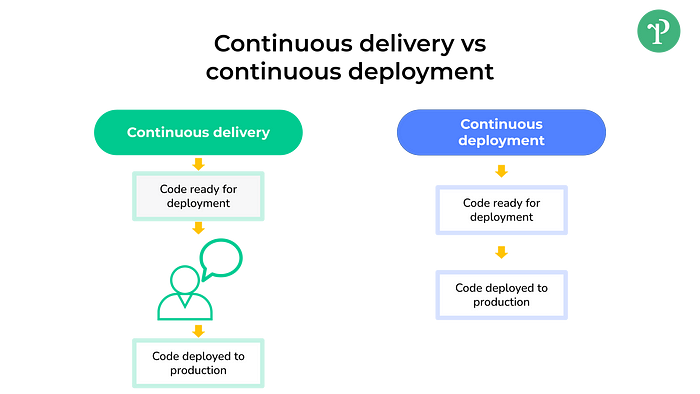
In the world of software development, two terms often get mixed up: continuous delivery and continuous deployment.
They might sound similar, but they have unique characteristics and are applied differently within the development process.
Let’s dive into a detailed comparison of continuous delivery vs deployment, shedding light on the nuances and understanding when and why to use each.
Continuous Integration: The starting point
Before we get into the details of continuous delivery and continuous deployment, it’s essential to understand the continuous integration phase.
Continuous Integration (CI) is the practice of integrating code changes from multiple contributors into the main codebase frequently.
This involves running automated tests to ensure that the new code doesn’t break anything, creating a solid foundation for both continuous delivery and continuous deployment.

Continuous Delivery (CD): Keeping things ready
Continuous delivery focuses on keeping the software in a state where it can be deployed to a production environment at any time. The key here is that the code changes go through a continuous delivery pipeline that involves automated testing and creating a release that’s ready to go live. However, deploying the software usually requires manual approval.
Automated release process
With continuous delivery, the entire process is automated up to the point of deployment. This includes testing automation, where automated tests are run to validate the code changes, ensuring everything works as expected.
Human intervention
Although the release is automated, human intervention is often required to push the final button and deploy the software to the production environment. This manual step allows for additional checks, a final review, or aligning the release with other business activities.
Staging environment
Before deploying software to the live environment, it’s often tested in a staging environment that mimics the production environment. This additional step ensures that everything works in a real-world setting without affecting actual users.
Continuous Deployment (CD): Full speed ahead
Continuous deployment takes the process a step further by automating the entire process, including the final deployment to production. If the code changes pass all the automated tests, they are automatically deployed to the live environment.
Automated deployment workflow
In continuous deployment, the deployment processes are fully automated. There’s no waiting for manual approval; the code changes go straight from the continuous integration server to live once they pass all the running automated tests.
Feedback loop
Continuous deployment creates a rapid feedback loop, allowing development teams to see how their code performs in the live environment quickly. This can lead to faster iterations and improvements.
Continuous deployment tools
Various continuous deployment tools help automate the workflow, linking the continuous integration process to deployment. These tools ensure a smooth transition from development to live, often working in conjunction with continuous integration servers.
Continuous delivery vs deployment: choosing the right approach

The choice between continuous delivery vs deployment depends on the needs and context of the project.
- Continuous delivery focuses on flexibility: If you need more control over when code goes live or if additional manual checks are required, continuous delivery provides that flexibility.
- Continuous deployment is about speed: If rapid, frequent releases are essential, and you have a robust set of automated tests to ensure quality, continuous deployment can provide a more streamlined, efficient approach.
Considerations for development teams
- Software development practice: Consider your team’s software development practice, how you work, what your goals are, and the level of confidence in your automated testing.
- Risk tolerance: Continuous deployment, while faster, may also carry more risk without manual checks. Consider the nature of the project and how critical any potential errors might be.
Conclusion
Continuous delivery and continuous deployment are both valuable strategies in modern software development. The difference mainly lies in the degree of automation and the presence or absence of a manual approval step before deploying software to the production environment.
Continuous delivery offers more control and may be suitable for complex or risk-averse projects. Continuous deployment is about speed and is best for teams that need to push changes quickly and have a robust testing framework in place.
Understanding continuous delivery vs deployment and choosing the right approach can streamline your development process, ensuring that your team can efficiently and effectively deliver quality software to your users.
